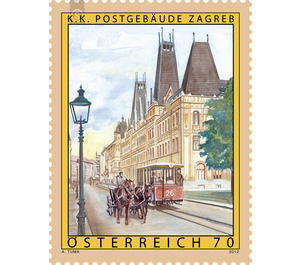Old Austria - Austria / II. Republic of Austria 2012 - 70 Euro Cent
Theme: History & Politics
| Country | Austria / II. Republic of Austria |
| Issue Date | 2012 |
| Face Value | 70.00 |
| Edition Issued | 400,000 |
| Printing Type | offset |
| Stamp Type | Commemorative |
| Item Type | Stamp |
| Chronological Issue Number | 2346 |
| Chronological Chapter | OOS-OE2 |
| SID | 508447 |
| In 58 Wishlists | |
With the new 70 cent value "Zagreb" the interesting special issue series "Old Austria" now finds its attractive continuation; the designed by Prof. Adolf Tuma brand motif shows the architecturally remarkable building of the former k.k. Post of Zagreb. History: The Kingdom of Croatia and Slavonia (Croatian: Kraljevina Hrvatska i Slavonija) was from 1745 as a by-country of Hungary, an autonomous kingdom within the Habsburg monarchy, but it also belonged to the time of Austro-Hungary Hungarian part of the Dual Monarchy and included parts of today's Croatia and Vojvodina. The so-called "Triune Kingdom of Dalmatia, Croatia and Slavonia" was created in 1745 by the unification of the kingdoms of Croatia and Slavonia; from 1767 to 1777 these areas were referred to as the Kingdom of Illyria. The then Venetian Dalmatia was only a nominal part of the country and was not even after the Austrian occupation in 1797 unified with the other two territories. After the Napoleonic occupation in 1818 Illyria was restructured, and now officially called "Kingdom of Croatia and Slavonia" area to the crown land. In 1849, then the crown land "Serbian Vojvodina", the former military border, was dissolved, and divided into Hungary and Croatia-Slavonia. The Hungarian-Croatian settlement of 1867 gave Croatia-Slavonia greater autonomy within the Hungarian crown. Contrary to the wishes of the Croatian majority population, however, a formal union with the Kingdom of Dalmatia, which remained part of the Austrian half of the empire, remained unaffected - the two crownlands were only allowed a common flag. The kingdom existed until 1918, when it was incorporated into the Kingdom of Serbs, Croats and Slovenes. After the proclamation of the Kingdom of Yugoslavia in 1929, a large part of the territory of Croatia-Slavonia became part of the Banava Sava. Zagreb itself was the seat of the former county Agram, which covered an area of more than 7,200 square kilometers; According to the census of 1910, the county had about 594,000 inhabitants. Today, Zagreb is the capital of Croatia and therefore also the most important business location of the country - pharmaceutical industry, electrical engineering, trade and tourism are the economic pillars of the city. Incidentally, the name Zagreb probably comes from "zagrabiti" (German: "draw water"), according to other sources Zagreb mean meanwhile "behind the mountains" or "behind the dam".


